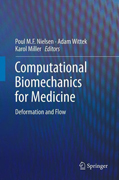
Computational biomechanics for medicine: deformation and flow
Nielsen, Poul M.F.
Wittek, Adam
Miller, Karol
One of the greatest challenges for mechanical engineers is to extend the success of computational mechanics to fields outside traditional engineering, in particular to biology, biomedical sciences, and medicine. This book is an opportunity for computational biomechanics specialists to present and exchange opinions on the opportunities of applying their techniques to computer-integrated medicine. Computational Biomechanics for Medicine: Deformation and Flow collects the papers from the Medical Image Computing and Computer Assisted Intervention conference (MICCAI 2011) dedicated to research in the field of medical image computing and computer assisted medical interventions. The topics covered include: medical image analysis, image-guided surgery, surgical simulation, surgical intervention planning, disease prognosis and diagnostics, injury mechanism analysis, implant and prostheses design, and medical robotics. Introduces a novel partnership between surgeons, biomechanical engineers, and experts in computational methods that helps overcome the limitations of traditional surgery. Covers Computer-Integrated Surgery (CIS) systems and. promotes a multidisciplinary approach that can improve clinical outcomes and the efficiency of health care delivery. Provides a unique collection of new researchin computational biomechanics gathered together in a single volume INDICE: Automatic quantification of congruity from knee MRI. Computationalfluid dynamics framework for large-scale simulation in pediatric cardiology. Effects of levator ani muscle morphology on the mechanics of vaginal childbirth. Human body joints tracking for clinical jumping analysis. Human supervisorycontrol framework for interactive medical image segmentation. Modeling heterogeneous tumor growth using hybrid cellular automata. Modelling prone to supinebreast deformation under gravity loading using heterogeneous finite element models. Neuroimage as a biomechanical model. Towards new computational biomechanics of the brain. Performing brain image warping using the deformation field predicted by a biomechanical model. Quadratic corotated finite elements for real- time soft tissue registration. The dependence of clinical metrics of cardiac function on lead position in cardiac resynchronization therapy- a biophysical modeling study. Toward computer modelling of blood flow in an anatomically accurate arterial tree in endovascular interventions. Multi-scale modeling andimaging of the failing heart: from mouse to human. Image-based CFD modeling of cerebral aneurysms.
- ISBN: 978-1-4614-3171-8
- Editorial: Springer US
- Encuadernacion: Cartoné
- Páginas: 100
- Fecha Publicación: 30/04/2012
- Nº Volúmenes: 1
- Idioma: Inglés
